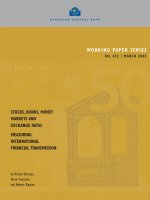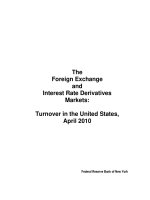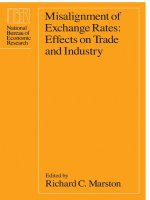FOREIGN EXCHANGE MARKETS AND EXCHANGE RATES RELATIVE PURCHASING POWER PARITY
Bạn đang xem bản rút gọn của tài liệu. Xem và tải ngay bản đầy đủ của tài liệu tại đây (576.92 KB, 15 trang )
FOREIGN EXCHANGE MARKETS AND EXCHANGE RATES - RELATIVE
PURCHASING POWER PARITY
I. Terminology
1. An American Depositary Receipt (ADR) is a security issued in the
United States that represents shares of a foreign stock, allowing that
stock to be traded in the United States.
2. The cross-rate is the implicit exchange rate between two currencies
(usually non-U.S.) when both are quoted in some third currency, usually
the U.S. dollar.
3. A Eurobond is a bond issued in multiple countries, but denominated
in a single currency, usually the issuer’s home currency. Such bonds
have become an important way to raise capital for many international
companies and governments.
4. Eurocurrency is money deposited in a financial center outside of the
country whose currency is involved.
5. Foreign bonds, unlike Eurobonds, are issued in a single country and
are usually denominated in that country’s currency. Often, the country
in which these bonds are issued will draw distinctions between them
and bonds issued by domestic issuers, including different tax laws,
restrictions on the amount issued, and tougher disclosure rules.
6.Gilts, technically, are British and Irish government securities, although
the term also includes issues of local British authorities and some
overseas public sector offerings.
7.The London Interbank Offered Rate (LIBOR) is the rate that most
international banks charge one another for loans of Eurodollars
overnight in the London market. LIBOR is a cornerstone in the pricing of
money market issues and other short-term debt issues by both
government and corporate borrowers.
8.There are two basic kinds of swaps = exchanging: Interest rate and
currency. An interest rate swap occurs when two parties exchange a
floating-rate payment for a fixed-rate payment, or vice versa. Currency
swaps are agreements to deliver one currency in exchange for another.
Often, both types of swaps are used in the same transaction when debt
denominated in different currencies is swapped.
II. FOREIGN EXCHANGE MARKETS AND EXCHANGE RATES
1.Foreign Exchange Markets
The foreign exchange market (also called the forex or FX market) is the
world’s largest financial market in which one country’s currency is
traded for another country’s currency.
The foreign exchange market is an over-the-counter market, so there is
no single location where traders get together. Instead, market
participants are located in the major commercial and investment banks
around the world. They communicate using computer terminals,
telephones, and telecommunications devices. One communications
network for foreign transactions is maintained by the Society for
Worldwide Interbank Financial Telecommunication (SWIFT), a Belgian
not-for-profit cooperative. Using data transmission lines, a bank in New
York can send messages to a bank in London via SWIFT regional
processing centers.
The many different types of participants in the foreign exchange market
include the following:
1. Importers who pay for goods using foreign currencies.
2. Exporters who receive foreign currency and may want to convert to
the domestic currency.
3. Portfolio managers who buy or sell foreign stocks and bonds.
4. Foreign exchange brokers who match buy and sell orders.
5. Traders who “make a market” in foreign currencies.
6. Speculators who try to profit from changes in exchange rates.
<chuyển slide>
2.Exchange Rates
a. Exchange Rate Quotations
A direct quote is a foreign exchange rate quoted in fixed units of foreign
currency in variable amounts of the domestic currency. In other words,
a direct currency quote asks what amount of domestic currency is
needed to buy one unit of the foreign currency—most commonly the
U.S. dollar (USD) in forex markets. In a direct quote, the foreign
currency is the base currency, while the domestic currency is the
counter currency or quote currency.
This can be contrasted with an indirect quote, in which the price of the
domestic currency is expressed in terms of a foreign currency, or what is
the amount of domestic currency received when one unit of the foreign
currency is sold.
The use of direct quotes versus indirect quotes depends on the location
of the trader asking for the quote, as that determines which currency in
the pair is domestic and which is foreign. Non-business publications and
other media usually quote foreign exchange rates in direct terms for the
ease of consumers. However, the foreign exchange market has quoting
conventions that transcend local borders.
A direct quote can be compared to an indirect quote as its inverse, or by
the following expression:
DQ = 1/IQ
b. Cross-Rate Triangle Arbitrage
A cross rate is a foreign currency exchange transaction between two
currencies that are both valued against a third currency. In the foreign
currency exchange markets, the U.S. dollar is the currency that is
usually used to establish the values of the pair being exchanged.
When a cross-currency pair is traded, two transactions are actually
involved. The trader first trades one currency for its equivalent in U.S.
dollars. The U.S. dollars are then exchanged for another currency.
In the transaction described above, the U.S. dollar is used to establish
the value of each of the two currencies being traded.
For example, if you were calculating the cross rate of the British pound
versus the euro, you would first determine that the British pound, as of
Dec. 18, 2020, was valued at 0.74 to one U.S. dollar, while the euro was
valued at 0.82 to one U.S. dollar.
Triangular arbitrage is the result of a discrepancy between three foreign
currencies that occurs when the currency's exchange rates do not
exactly match up. These opportunities are rare and traders who take
advantage of them usually have advanced computer equipment and/or
programs to automate the process.
A trader employing triangular arbitrage, for example, would exchange
an amount at one rate (EUR/USD), convert it again (EUR/GBP), and then
convert it finally back to the original (USD/GBP), and assuming low
transaction costs, net a profit.
Example of Triangular Arbitrage:
As an example, suppose you have $1 million and you are provided with
the following exchange
rates: EUR/USD = 1.1586, EUR/GBP = 1.4600,
and USD/GBP = 1.6939.
With these exchange rates there is an arbitrage opportunity:
Sell dollars to buy euros: $1 million ÷ 1.1586 = €863,110
Sell euros for pounds: €863,100 ÷ 1.4600 = £591,171
Sell pounds for dollars: £591,171 x 1.6939 = $1,001,384
Subtract the initial investment from the final amount: $1,001,384 –
$1,000,000 = $1,384
c. Types Of Transactions
There are 2 basic types of trades in the foreign exchange market: spot
trades and forward trades
3.1. Spot trade
A spot trade is an agreement to exchange currency “on the spot”, which
means that the transactions will be completed or settled within two
business day.
The exchange rate on a spot trade is called the spot exchange rate.
All of the exchange rates and transactions we have discussed so far have
reffered to the spot market.
3.2. Forward trade
A forward trade is an agreement to exchange currency at some time in
the future.
The exchange rate that will be used is agreed upon today and is called
the forward exchange rate.
A forward trade will normally be settled sometime in the next 12
months.
3.3. Figure 21.1
If you look at Figure 21.1, you will see forward exchange rates quoted
for some of the major currencies. Suppose the spot exchange rate for
the Swiss franc is SF 1=$1.1373. The 180-day (6 months) forward
exchange rate is SF 1=$1.1391. This means you can buy a Swiss franc
today for $1.1373, or you can agree to take delivery of a Swiss franc in
180 days and pay $1.1391 at that time.
The Swiss franc is more expensive in the forward market
($1.1391>$1.1373). Because the Swiss franc is more expensive in the
future than it is today. It is said to be selling at a premium relative to the
dollar. For the same reason, the dollar is said to be selling at a discount
relative to the Swiss franc.
The forward market exists to allow businesses and individuals to lock in
a future exchange rate today, thereby eliminating any risk from
unfavorable shifts in the exchange rate.
III. Purchasing Power Parity
1,Absolute purchasing power parity:
a, Definition:
Absolute purchasing power parity (APPP) is the basic PPP theory, which
states that a commodity costs the same regardless of what currency is
used to purchase it or where it is sold. A more simple idea is once two
currencies have been exchanged, a basket of goods should have the
same value.
⇒ The theory is based on converting other world currencies into the US
dollar.
For example: If the price of a can of coca cola cost $1.50 USD in The US,
and the exchange rate is €0.7 per euro, then through APPP a coca cola
can should cost €2.14 EUR in Germany.
⇒ In other words, absolute PPP implies that $1.50 USD will buy you the
same number of coca cola can anywhere in the world.
b, How to calculate using APPP:
To be more specific, if:
·
S0 is the spot exchange rate between the EUR and the USD (Time 0)
·
PUS and PEU as the current US and Europe prices
Respectively, on a particular commodity, using Absolute PPP will tell us
that:
PEU = S0 × PUS
⇒ This means the Europe price for something is equal to the U.S. price
for that same
thing multiplied by the exchange rate.
The rationale behind PPP is similar to that behind triangle arbitrage.
Unless PPP hold, arbitrage would be possible if apples were moved
from one country to another. Suppose apples are selling in The US for
$4, whereas in Europe the price is €2.40. Absolute PPP can implies that:
€2.40 = S0 × $4
S0 = €2.40/$4 = £0.60
That is, the implied spot exchange rate is€ 0.60 per dollar. Finally, a euro
is worth:
$1/€0.60 = $1.67.
Suppose that, instead, the exchange rate is €0.50. Starting with $4, a
trader could buy apples in The US, ship them to Europe, and sell them
there for €2.40. Our trader could then convert the €2.40 into dollars at
the prevailing exchange rate, S0 = €0.50, yielding a total of €2.40/0.50 =
$4.80. The round-trip gain would be 80 cents.
Because of this profit potential, forces are set in motion to change the
exchange rate or the price of apples. In our example, apples would
begin moving from The US to Europe. The reduced supply of apples in
the US would raise the price of apples there, and the increased supply
in Europe would lower the price of apples.
In addition to moving apples around, apple traders would be busily
converting euros back into dollars to buy more apples. This activity
would increase the supply of euros and simultaneously increase the
demand for dollars. We would expect the value of a euro to fall. This
means that the dollar would be getting more valuable, so it would take
more euros to buy one dollar. Because the exchange rate is quoted as
euros per dollar, we would expect the exchange rate to rise from €0.50.
c, Conclusion:
Now we learn that for absolute PPP to hold absolutely, several things
must be true:
· The transaction costs of trading apples - shipping, insurance,
spoilage, and so on, must be zero.
· There must be no barriers to trading apples - no tariffs, taxes, or
other political barriers.
· Finally, traded goods in The US must be identical to the one in
Europe. With the example above, this means that absolute PPP won’t
apply to people who send red apples to Europe if the locals eat only
green apples.
Given the fact that the transaction costs aren’t free and that the other
conditions are rarely met, it is not surprising that absolute PPP is really
applicable only to traded goods, and then only to very uniform ones.
⇒ For this reason, absolute PPP does not imply that a Mercedes costs
the same as a Ford or that a nuclear power plant in Russia costs the
same as one in Germany. In the case of the cars, they are not identical.
In the case of the power plants, even if they were identical, they are
expensive and would be very difficult to transfer. On the other hand, we
would be surprised to see a significant violation of absolute PPP for
gold.
RELATIVE PURCHASING POWER PARITY
Definition
Relative Purchasing Power Parity (RPPP) is an expansion of the
traditional purchasing power parity (PPP) theory to include changes in
the exchange rate with inflation over time.
To make it easier to understand, RPPP does not tell us what determines
the absolute level of the exchange rate. Instead, it tells what determines
the change in the exchange rate over time
For example: Suppose the British pound–U.S. dollar exchange rate is
currently S0 = £.50, the inflation rate in Britain is predicted to be 10
percent over the coming year, and (for the moment) the inflation rate in
the United States is predicted to be 4 percent.
=> The prices in Britain are rising at a rate of 10% − 4% = 6% per year,
the predicted exchange rate is £.50 × 1.06 = £.53.
How to calculate RPPP
In general, relative PPP says that the change in the exchange rate is
determined by the difference in the inflation rates of the two countries.
Based on our preceding discussion, to be more specific, we will use the
following notation:
S0 = Current (Time 0) spot exchange rate (foreign currency per
dollar)
E(St ) = Expected exchange rate in t periods
hUS = Inflation rate in the United States
hFC = Foreign country inflation rate
Relative PPP says that the expected percentage change in the exchange
rate ov er the next year, [E(S1 ) − S0 ]/S0 , is:
[E(S1 ) − S0]/S0 = hFC − hUS
=> E(S1 ) = S0 × [1 + (hFC − hUS)]
In words, relative PPP says that the expected percentage change in the
exchange rate is equal to the difference in inflation rates.
In our example involving Britain and the United States, relative PPP tells
us that the exchange rate will rise by hFC − hUS= 10% − 4% = 6% per
year. Assuming the difference in inflation rates doesn’t change, the
expected exchange rate in two years, E(S2 ), will be: E(S2 ) = E(S1 ) × (1 +
.06) = .53 × 1.06 = .562
So, the overall formula of exchange rate in the future is
E(St ) = S0 × [1 + (hFC − hUS)]t
Relative PPP also tells us that the exchange rate will rise if the U.S.
inflation rate is lower than the foreign country’s inflation rate. This
happens because the foreign currency reduce in value and weakens
relative to the dollar.
3. Conclusion
Relative purchasing power parity (RPPP) is an economic theory that
exchange rates and inflation rates (price levels) in two countries should
equal out over time.
Relative PPP is an extension of absolute PPP in that it is a dynamic (as
opposed to static) version of PPP.
While PPP is useful in understanding macroeconomics in theory, in
practice RPPP does not seem to hold true over short time horizons.









